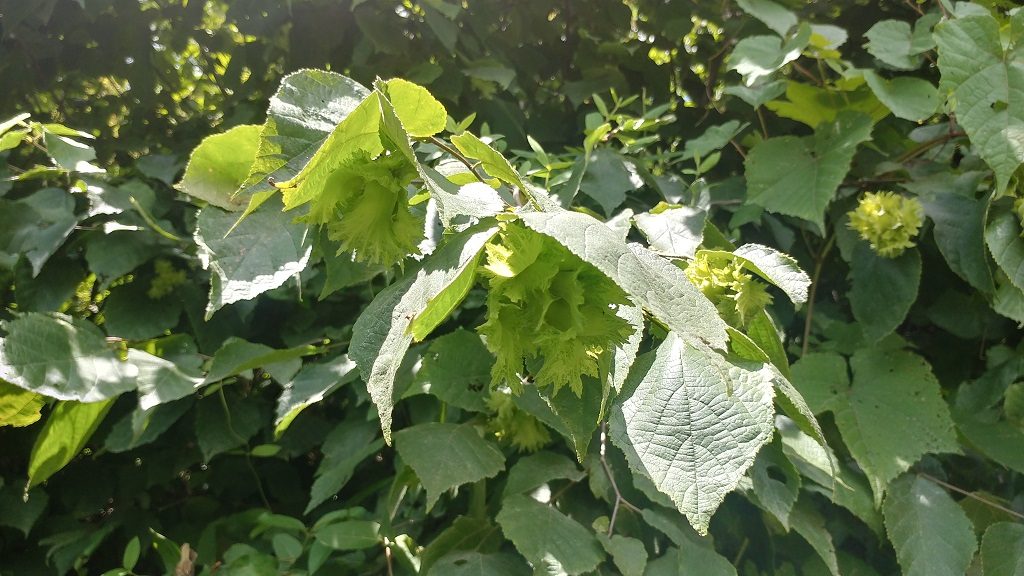
It is intimidating to begin writing about the hazelnut. Venerated for centuries in Europe as bestowing wisdom, knowledge, and health upon those who eat it, I can instinctively understand why. Hazelnuts are capable of providing for all of our staple dietary needs. They are tasty, good raw or cooked, and rich in unsaturated fats – up to 65% – also containing lots of phytoserols, proteins, vitamins, and minerals. Hazelnuts are productive, hardy, easy to work with, and the hazel wood has many uses from cordage to basketry, to woven fencing, to pruning and coppicing for fuel. Hazel wood can also be used medicinally in similar ways as the witch-hazel (Hamamelis). Hazels are a pioneering species, and are the first arrivals in several ways. They are the first to flower in the winter. Of all the nut-bearing plants they are the quickest to bear when grown from seed (doing so after just the first year, in exceptional cases). When the glaciers retreated ten thousand years ago, hazels were the first deciduous tree to colonize Europe (Pollen records show that hazelnut appeared in a dramatic flash, seemingly out of nowhere, 9-10 thousand years ago across that continent; it has been suggested that human actions were the cause.1). Hazels are one of the friendliest of nut trees. There are so many superlatives for such a humble plant.
The hazelnut provides excellent browse for deer and rabbits, and its leaves can host a wide variety of larvae and lepidoptera. The hazelnut cambium is among the most favored food of all by beavers, alongside aspen, birch, and alder. The nuts have been cherished not only by humans, but also by squirrels, other rodents, turkeys, grouse, quail, pheasants, geese, woodpeckers, the extinct passenger pigeon, foxes, raccoons, and deer. So many people love and value the hazel, whether they have two legs or four, wings or fingers. I hope I can write about the plant truthfully and with due reverence.
Hazels are members of the birch family Betulaceae, and are monoecious, having both male and female flowers on the same plant which bloom during the winter months. Male flowers or “staminate flowers” are also known as catkins, and female flowers or “pistillate flowers” are small, red, wispy-looking things. Hazels have leaves that are broad, generally rounded, with serrated or doubly-serrate margins, and parallel veins. Hazels are usually shrubs, although there is at least one tree-form species, the Turkish Tree Hazel, Corylus colurna, which can grow up to 80 feet high and stand tall in the canopy of a forest.
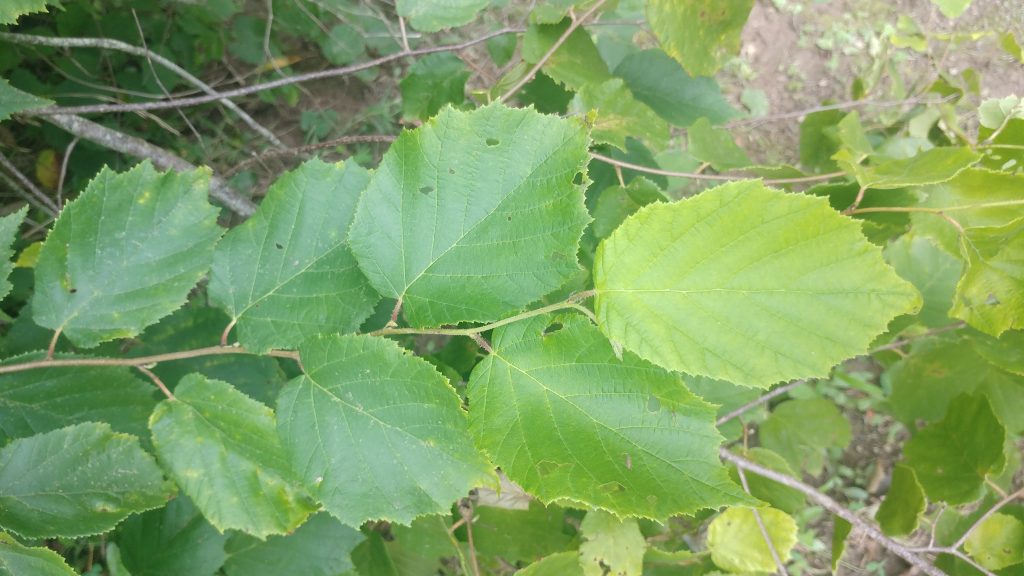
As a crop, 99% of all the hazelnuts grown commercially in North America come out of the Willamette Valley in Oregon. Globally, Turkey, Italy and Oregon lead in commercial hazelnut production. So if you’ve ever eaten hazelnuts from a market, they probably came from there. Nearly all commercial hazelnuts are some variety or cross of Corylus avellana or Corylus maxima, the European hazels, which produce best in maritime climates where the summers are mild and so are the winters.
Although the hazel is most famously associated with ancient European culture and European genotypes, plants in the hazelnut genus Corylus are dispersed across the temperate regions of the Northern Hemisphere, from Europe through Asia, and across North America. Yes, there are hazels native to right here in the Americas!
Some would be surprised to learn that across eastern North America, hazelnut is a common shrub in some places such as in the upper Midwest, where Corylus americana and its hybrids have been pushed as a commercial crop in recent decades, encouraging breeder’s selections for larger, thinner-shelled nuts. Traditionally, North American hazelnuts were used as food by indigenous people across the continent, and planted in forest gardens.
In North America east of the Rocky Mountains, the common hazelnut species is Corylus americana. Corylus americana, the American hazel, is cold hardy down to at least USDA zone 4b. It is moderately drought hardy, and also tolerates periodic inundation and flooding as along a riverway, though it prefers a well-draining soil. The stems of American hazelnut are fuzzy with fine hairs along the tips of the branches. The plant is a shrub, growing no taller than about 10-12 feet, and its roots sucker up and bunch at the base in a clustering thicket of branches, which at full height, gently arch skyward and outward, circumscribing a circle in a form like a vase.
A second species also exists in North America, the beaked hazelnut Corylus cornuta. It’s range is the same as the common hazelnut, but extends further west and further north. Corylus cornuta, the beaked hazelnut, is split into two varieties or species. Corylus cornuta var. cornuta is found in the circumboreal regions of North America, and especially east of the continental divide, whereas Corylus cornuta var. californica (aka Corylus californica) is found on the west side of the continental divide. The western beaked hazel grows taller than its eastern sibling – up to 45 feet high – and is especially found among the coastal mountains of the Pacific Northwest. Unlike Corylus americana which has suckering roots that bunch around the base of the shrub, Corylus cornuta has stoloniferous roots, meaning one individual’s roots can move along for a few feet or a few yards underground, growing laterally, and eventually forming a clonal thicket. It is also better able to resprout after fire, supposedly, and is better adapted for drier, upland soils and conditions.
Compared to the American hazelnut, the beaked hazelnut is more difficult to work with from a human standpoint. For one, beaked hazels generally don’t produce as many nuts. Although hazelnut as a genus is monoecious, having both male and female flowers on the same individual, in beaked hazelnut’s case, for whatever reason, they tend to produce a higher ratio of staminate or male flowers (the catkins), with a correspondingly low ratio of pistillate or female flowers. As only female flowers develop into nuts, this means beaked hazels aren’t very bountiful. Common hazelnut, by contrast, is more balanced, having a male/female ratio of about 50:50, and that means heavier cropping.
Another reason the beaked hazelnut is less desirable as a food is because of its long involucre or “beak,” which is bristly and spiny. The long, bristly beak of the husk surrounding a nut keeps it from being eaten prematurely, and also from falling out unprotected. The bristly, sticky covering is a deterrent to would-be nut predators, including human hands. The nuts of beaked hazelnut also supposedly have thicker shells and smaller meat than Corylus americana.
Because the beaked hazelnut may be considered the hardiest hazel of them all – it is in fact possibly the most northerly nut-bearer in all the world – it has some very desirable genetic properties from a breeder’s viewpoint. Beaked hazel is more drought and fire tolerant, as well as the coldest hardy, surviving winters down to -58F. One of the reasons why the beaked hazel is so cold hardy is that it develops its nuts earlier in the year. By late summer – late July, August – beaked hazel nuts begin to ripen. Burnt Ridge Nursery in Washington offers a hybrid of Corylus cornuta x avellana called “Peace River,” named for where the beaked hazelnut parents were collected in Alberta, Canada, and it is ideal for cold northern regions.
I should point out that I don’t have much personal experience with beaked hazels. During my travels around Oregon and the Pacific Northwest, I recall encountering several beaked hazel bushes. I even gathered and ate a few nuts. I have seen beaked hazels also in the Appalachian region but have not harvested the nuts there. Although a comparison of the size and productivity of American hazel vs. the beaked hazel favors the American, the beaked hazel is still a wonderful and worthy plant to grow, and possibly the only option in cold or dry northern climates.
Beaked hazel enjoys a rich history of traditional use by cultures throughout the Pacific Northwest, such as the Tsimshian of British Columbia. Writes James Andrew McDonald in “Robin Town: A Return to Robin Town on the Kitsumkalum Canyon”2:
Hazelnuts (Corylus corunta) were one of the few types of seeds eaten aboriginally. A small, branchy shrub, the hazelnut produces a favoured food that has a sporadic distribution. An unusual northern distribution is centred on the Hazelton area and includes the Kitsumkalum Valley. Hazelnut shrubs grow in well drained but moist sites, in open forest and shady openings such as clearings. Many shrubs can still be found throughout the Robin Town area. Several house sites along the canyon, such as at Gitmiinłgalaaw, have hazelnuts growing along the outside of the house depressions. This is not accidental but a result of gardening. The old people brought the hazelnut shrubs to Robin Town using saplings from Kitselas Canyon and planted the bushes where they were convenient.
Hazelnuts were valuable as food and peoples who were not in a hazelnut area often travelled to obtain them. At Kitsumkalum Canyon, there were lots to be picked and stored.
“And you know those nuts [Hazel nuts], the round ones. There is lots up there, too. We used to fill up pails.”
The Robin Town shrubs are now untended and wild but while Robin Town was inhabited, they must have added much to the landscaped appearance of the community.
The ethnobotanist Nancy J. Turner is a wonderful knowledge keeper for many indigenous traditions. She accompanied Jim McDonald, quoted above, on a trip to Robin Town in 2008. Writing in “Plant management systems of British Columbia’s first peoples”3, she says:
In many places in British Columbia, generations of management and use of plants have transformed entire landscapes into cultivated ecosystems (Johnson and Hunn 2010). Robintown in the Skeena region is one such place. This now-vacated settlement was occupied by the Kitsumkalum Ts’msyen until the mid- to late-1800s. Archaeological evidence (terraces, fishing stations, pathways, and cmts) and oral history suggest multiple generations of occupancy. Evidence of an ancient connection to the landscape and management of important plants is reflected today in the distribution, form, and immense range of culturally important plant species. Prominent among them are Pacific crabapple (Malus fusca) and hazelnut (Corylus cornuta) as well as dense patches of northern riceroot (Fritillaria camschatcensis), stinging nettle (Urtica dioica), and a multitude of berry species.
[..]
Hazelnut (Corylus cornuta) was also prominent in the orchard gardens. The nuts were formerly eaten in large quantities, and it is this species after which the town of Hazelton is named. Hazel branches are also sometimes used for cordage. Hazelnut may have originally been transplanted to Robintown as saplings, as these were known to have been distributed from Kitselas Canyon to other sites, including the townsite at the mouth of the Kitsumkalum River. As McDonald (2003, 57) notes:
“People now consider the presence of [hazel]nut trees and crabapple trees to be a sure sign of an old residential community or camp site.”
Beaked hazelnuts were also used by the Ojibwe where they were known as baga’ nak, short for ba’ gana’ mîc, “nut tree.”4
In eastern North America, we know through archaeology that the American hazelnut was important to first peoples:
In the Eastern Woodlands, hazelnuts [identified as Corylus americana] were used alongside hickory and walnut from at least the Early Archaic, but are less abundant than these other staple nut crops in the archaeological record for most time periods. [..] During the Middle Woodland in the American Bottom and Illinois River Valley, hazelnut shell abundance increases sharply in archaeological contexts and is more frequently recovered than in any other time period (Simon and Parker 2006:224).5
On his wonderful blog “Nature in Humanity” promoting what he calls native plant agriculture, Solomon Abbay Gamboa writes of old colonizer accounts noting “extensive Wild Plum, American Hazelnut, [and] Wild Crab Apple thickets promoted and managed by indigenous people for food, so thick horses couldn’t navigate through them.”6
In 1884, in a report on the state of Michigan as the white man first found it, an author writes beautiful, haunting passages invoking the now-lost cultural landscapes which were the legacy of the native peoples of the land. Hazelnuts make a feature of prominence, and were said to bear an “abundance of their fruit.” The writer also makes mention of “oak openings” or bur oak savannas.
In the forest we found the whole family of oaks, of the Michigan family, some twelve different kinds, and among them the burr oak, bearing an acorn good to eat, and on which hogs would fatten. In the timbered lands were the new trees called the whitewood [tulip poplar?], of which the best timber for building was made; and the black walnut, more valuable than cherry for cabinet work. It also bore a large and very rich nut, and with it were the whole family of the hickories, all bearing good eatable nuts. Besides these were the butternut, the beechnut, and the hazelnut, all bearing an abundance of their fruit. Throughout the woods we saw the grape-vine hanging from the trees laden with its fruit. We saw vast thickets and long rifts of blackberry bushes lately burdened with their tempting berries. And we were told that the woods and hillsides and openings, in their season were fairly red with the largest and most delicious strawberries, while the wild plum grew along the small streams, the huckleberry and the cranberry on the marshes, and the aromatic sassafras was found throughout the woods. The annual fires burnt up the underwood, decayed trees, vegetation, and debris, in the oak openings, leaving them clear of obstructions. You could see through the trees in any direction, save where the irregularity of the surface intervened, for miles around you, and you could walk, ride on horse-back, or drive in a wagon wherever you pleased in these woods, as freely as you could in a neat and beautiful park.7
On the prairies of Kentucky, traveler James Flint writes:
In the neighborhood of Salt River and Green River, in Kentucky, there are extensive tracks of barren wastes. Small hazel bushes from two to three feet in height abound in these; and the quantity of nuts produced exceeds anything of the kind which I have ever seen. . . . 8
According to BRIT, the Native American Ethnobotany Database9, American hazelnuts were used as food by the Cherokee, Chippewa, Dakota, Iroquois, Menominee, Meskwaki, Ojibwa, Omaha, Ponca, Winnebago, and Abnaki. No doubt Corylus americana played an important role in the aboriginal landscapes of eastern North America, and it goes on to play an important role in the ecosystems of today.
Mention of hazelnuts can be found in some placenames, for example in Hazelton, Pennsylvania. According to Wikipedia:
The Moravians, a Christian denomination, had been using “Warrior’s Trail” since the early 18th century after the Moravian missionary Nicolaus Ludwig Zinzendorf first used it to reach the Wyoming Valley. This particular stretch of “Warrior’s Trail” had an abundance of hazel trees. Though the Moravians called the region “St. Anthony’s Wilderness,” it eventually became known as “Hazel Swamp,” a name which had been used previously by the Native Americans.10
Reference to hazelnut is also given as Filbert Street in the city of Philadelphia – when the city was designed in the late 1600s by William Penn, the roads were all named after trees found within the fledgling commonwealth.
In present-day Pittsburgh, the neighborhood of Hazelwood was named for the large amount of hazel trees growing along the Monongahela River at the time of colonization.11 In Missouri, there is another town bearing the name of Hazelwood and it is likely named for the American hazelnut, as well.
Harvest
Following flowering in the late winter and into the early spring, the male catkins wither and dry on the bush, and the pollinated female flowers develop into tiny clusters of nuts. At the same time, following flowering the hazels begin leafing out. By the time of midsummer comes around, the nuts on the hazelnut have become noticeable.
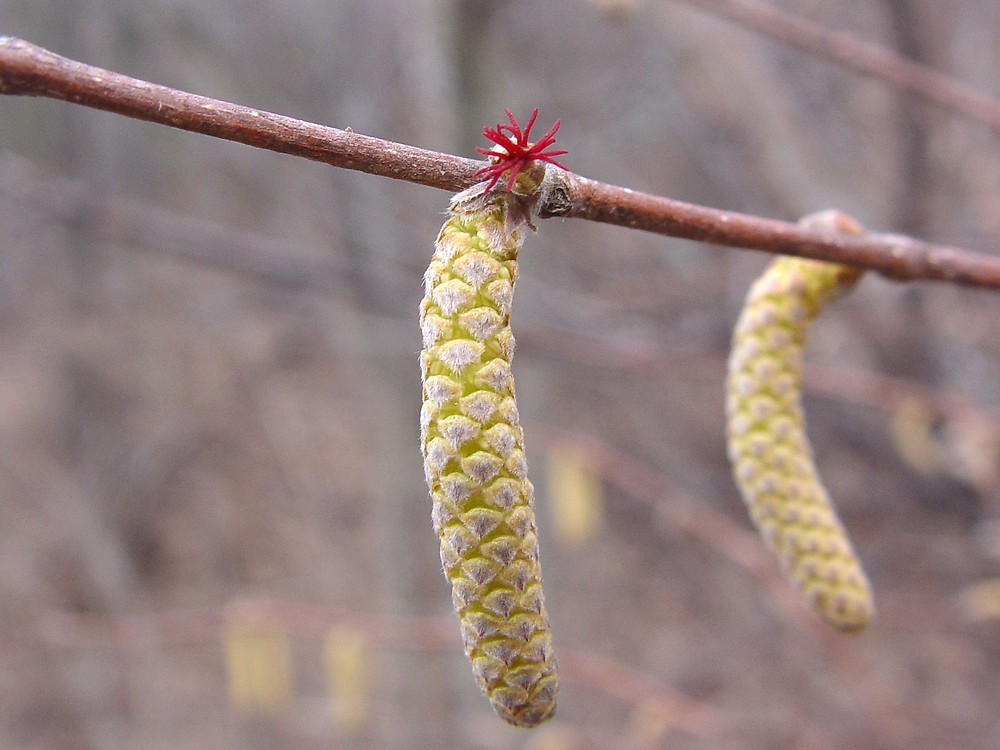
The nuts of the American hazelnut sometimes grow singly, but usually they grow in clusters of anywhere from 2, 3, 4, 5, or all the way up to 9 nuts to a cluster. The nuts in each cluster continue to develop, gradually growing in size until about the end of August for some clusters through to about the middle of September for others. Only then, do they begin to ripen.
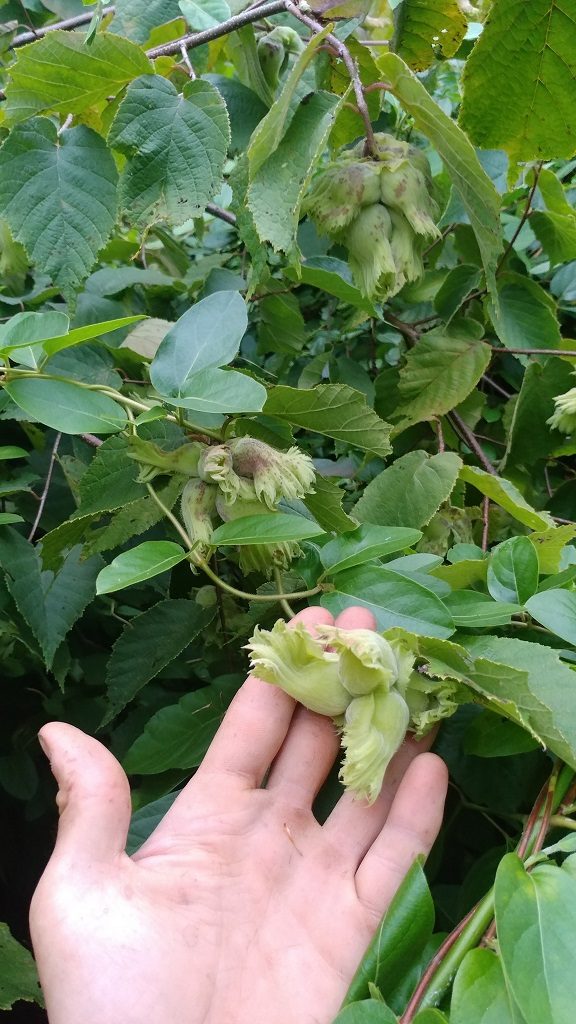
The ripening process takes about two weeks. This process could be considered something like a “hardening off” or a “drying down.” If the nuts are gathered off the tree too early, they are unfilled – just empty shells. But if you wait too long to gather the nuts, the squirrels will get to them first. Like birds who eat berries before they are ripe, squirrels share in the annoying habit of decimating the hazels before the nuts have fully ripened on the bush.
In order to beat the squirrels, there are a few tricks. One of these is a visual inspection. Have the involucres or husks surrounding the nuts begun to show any signs of drying: brown spots, or brown patches? If you can see to the actual nut, is it fresh and green, or has the tip begun to brown? If you answered yes to the first question – browning on the husk, but the nuts are still green – then you may get away with harvesting now and letting the nuts ripen off the bush. Better yet, if you can answer yes to both of these questions, then the cluster is definitely ready to be picked, and you can feel better knowing that the risk of your harvest being premature is passed.
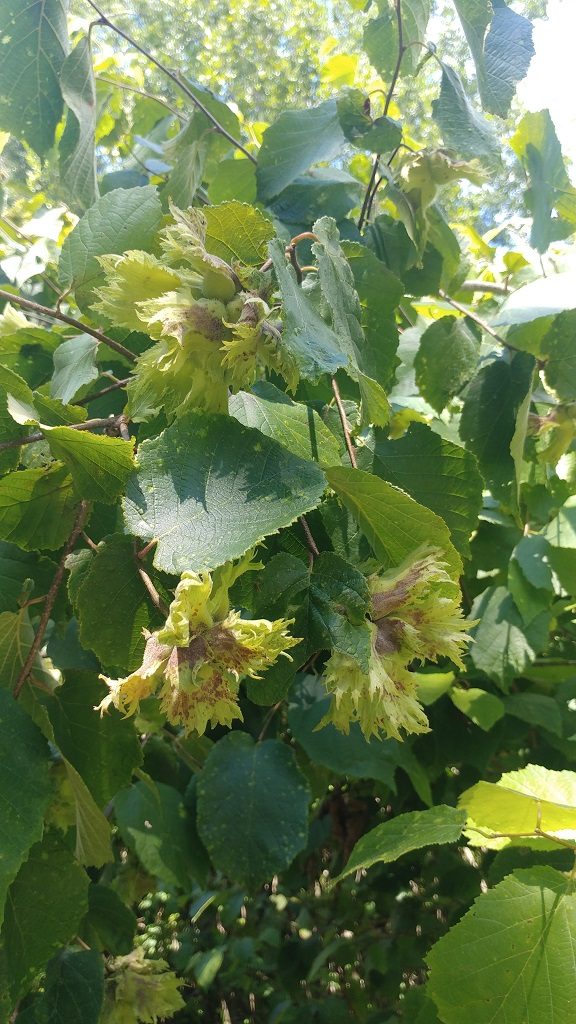
Left alone on the bush, the husks will continue drying down to a solid chestnut-brown, as do the nuts themselves. As the husks dry and shrink, they release the nuts which drop onto the ground. That is, if the squirrels didn’t get to them first!
When I was teaching myself how to time the harvest of the hazelnuts, I would sometimes sacrifice a nut from a cluster in question and cut it in half with my Felco No. 2 pruners. If the nut meat was fully filled inside the shell, then I knew that the cluster was ready for harvest. If not, keep waiting!
Another way to gauge the ripeness of the nuts is whether they release readily from within their husk. In the anatomy of a nut, the hymenium is the part on “top” of the nut, which is lighter in color. It is where the nut was bonded to the bud. If the hymenium is still bonded to the involucre, the nut isn’t ready to ripen.
Clusters of nuts should be considered individually. Sometimes a hazelnut will ripen its various clusters of nuts at different times, based on who knows what factor. Perhaps it is sequential from time of pollination, or maybe it is access to sunlight. Occasionally all the clusters on the bush are ripe around the same time. But usually their ripening is slightly staggered. Although nuts within a cluster all generally ripen about the same time, not all the clusters will. There will be early clusters, and there will be late clusters. Keep this in mind.
Your harvesting habits in this regard may depend on accessibility. If you can visit the hazelnut bush every day, then it is best to harvest the nuts over an extended period of time, after each cluster reveals its ripeness. But sometimes you know you will never visit the bush again, or at least not without difficulty, and in that case it might make sense for you to also harvest some clusters still a bit on the early side.
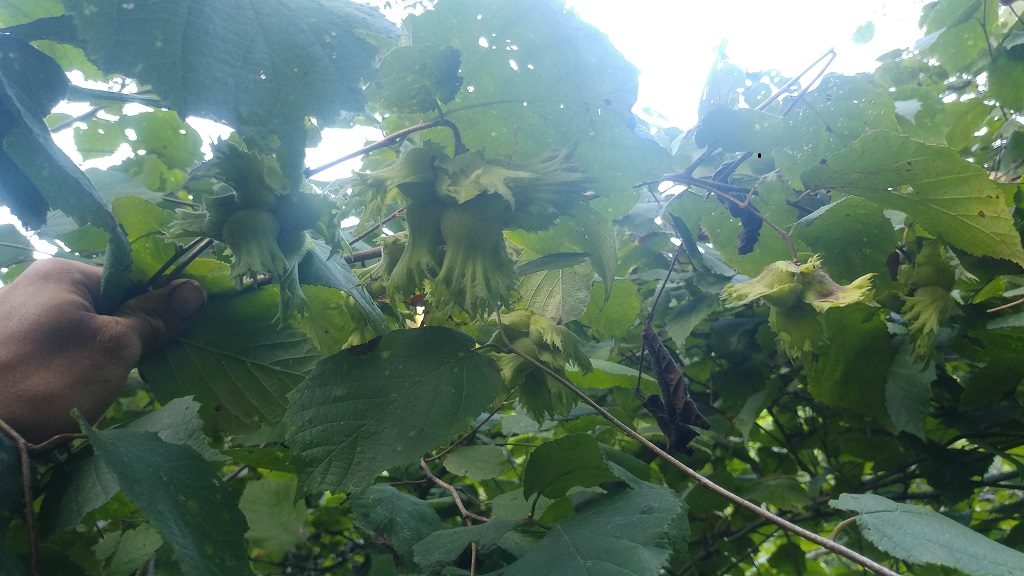
Harvesting hazelnuts is a joy. The clusters pick off the bush like apples and fit comfortably in your hand like one, too. If a cluster is too high to grab, you can just reach for one of the supple trunk branches at breast height and bend it down to where the clusters can be reached. At a good stand of hazels, you ought to be able to fill several 5 gallon buckets in an hour or two. Picking is the easy part – it is in the processing where the real work begins.
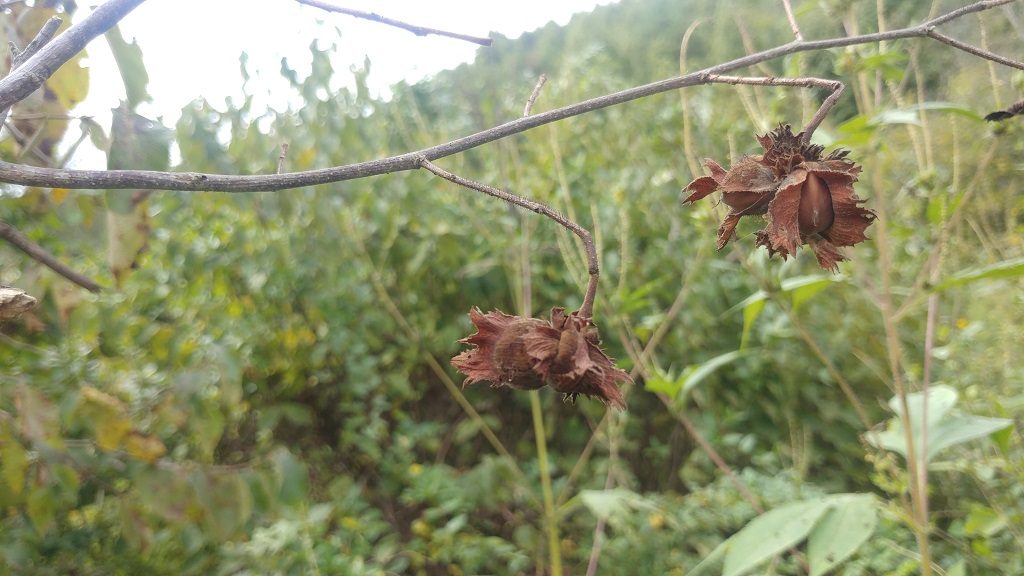
Hazel production is traditionally rejuvenated through coppicing. Coppicing is an ancient technique where the trunk of a tree or shrub is cut down to the ground and allowed to resprout. Each time the tree or shrub resprouts, it grows anew from the same old roots. Individual copses have been found to be thousands of years old.12 Theoretically, one can coppice the same individual tree indefinitely.
From what I’ve read, supposedly individual trunks of Corylus americana only fruit every three years, or something like that. If this is true – something to be verified over coming years – then it would seem the best practice for managing American hazelnut is timed conveniently at the same time as harvest. After all the last clusters of nuts are harvested, cut the fruiting trunk to the ground, leaving all non-fruiting trunks for next year’s production.
Another idea I had is to cut the whole hazel trunk at its base when the first clusters are ready for harvest, but without picking off any of the clusters. This way you can take the whole branch and hang it over the rafters and let the nuts ripen “on the vine,” using up the latent energy within the cut hazel wood, and letting the nuts drop of their own accord when ready, into the catchment below of your choosing. You can even use the hazel wood to keep your fire kindled as you process the hazelnuts for eating throughout the winter months!
Processing hazelnuts can be split into two different phases. The first phase is separating the nuts from the husks. If you managed to harvest your nuts without the husks attached, congratulations!… you can skip ahead. Otherwise, you will need to let the hazelnut clusters dry pretty well before beginning the threshing process. Laying them out on a tarp for a week or two in a warm, dry place (such as a shed) is ideal. Once the husks have dried, you can thresh them by hand, by machine, or my favorite method: by foot. As the husks break down, the nuts are released, and the bits of husk may be gradually winnowed away and the nuts picked out.
The second phase is cracking the hazelnuts and separating out the meat from the shell. Unfortunately, no one has yet devised a really efficient way to do this. Both the nut meats and the shell pieces sink in water, so float separation will not work. The nut meats also weigh similarly to the bits of shell, therefore winnowing does not work either. We’ve been cracking the hazelnuts in bulk with a DaveBilt nutcracker, and then spend some time picking out the meats by hand. It can be tedious work, but fortunately hazelnuts store inside the shells well for a year or two, so you can do the work gradually.
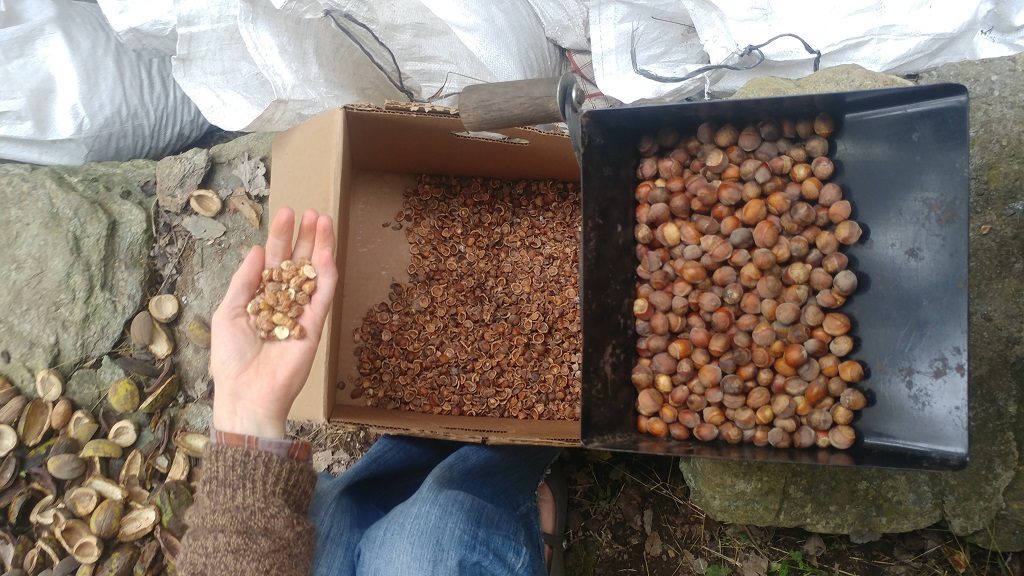
I did try to make a hazelnut milk once in the same way pawcohiccora (hickory nut milk) is made: by adding water to the cracked shells and nut meats, and leaving to simmer for a few hours. To my disappointment, I found that this method does not work – tannins and other compounds in the shells impart off flavors onto the brew, resulting in an unpalatable cocktail. It seems I’ll have to settle for the slow and steady method of cracking and picking for now…
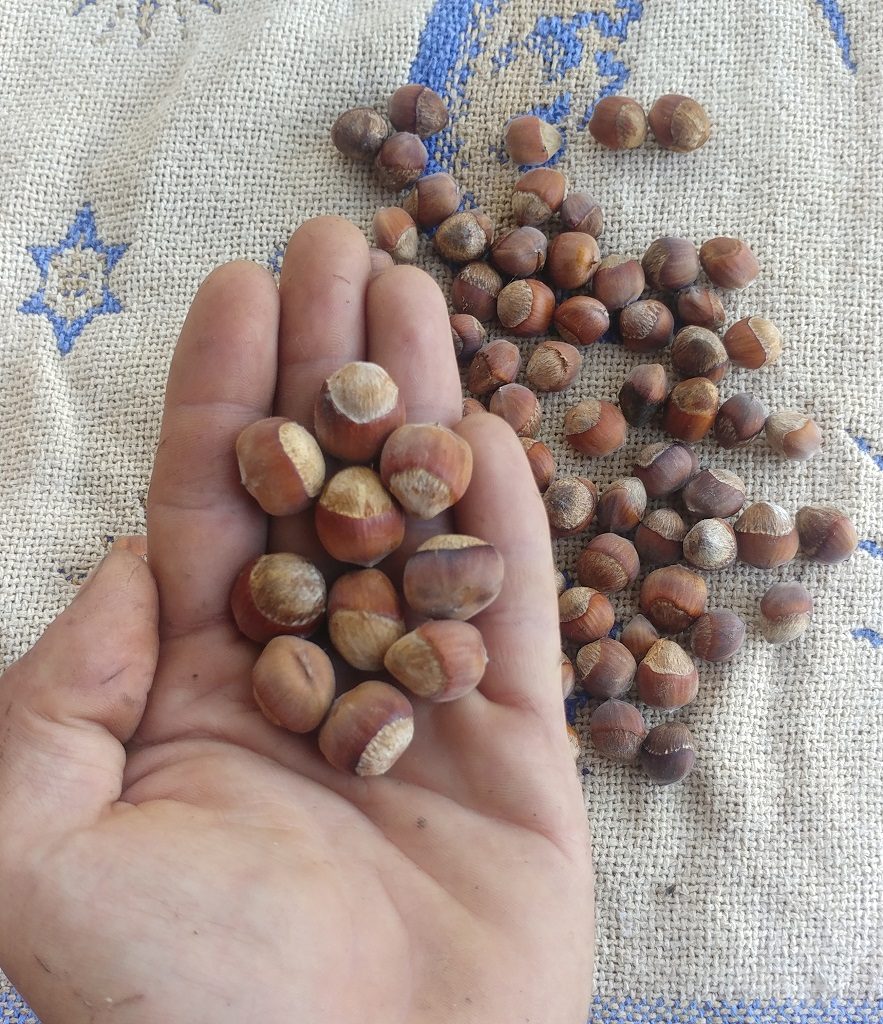
Hazelnuts are excellent roasted. This is done by putting them in an oven for 15 to 20 minutes or over a fire briefly. You want them to turn a light, golden brown, but you don’t want them to burn. Your nose will be your guide – it knows when they are ready! Their aroma is heavenly. After they have been roasted, they can be ground down into a flour, and stored in an air-tight container. Nut flours will go rancid if let to sit too long, therefore it is best to store them in a refrigerator or spring house between uses, or in the freezer for long-term storage.
Propagation & Cultivation
Hazels can be propagated in three main ways: by seed, by layering, and by grafting. Growing from seed is my favorite way. You never know what you’re going to get. Every seed grows into an individual with their own set of unique traits and distinguishing features. Hazels grown from seed do not always take on the traits of their parents, but they grow more true than some other species, such as hickory.
Hazelnut seeds retain viability best if kept somewhat moist and in a cool, dark place. They can be stored in these conditions for at least two years. Naturally they must go through a period of cold-moist stratification before they germinate. By sowing in the fall, and letting nature take her course throughout the winter, she’ll do all the work for you and the hazelnuts will sprout when they are ready. However, there is also the risk that squirrels or other rodents will dig up and eat your hazelnuts before they get the chance to grow. To get around this, you can simulate winter by storing moistened hazelnuts in a bag in the fridge over the winter. Or better yet, you can bury them in a rodent-proof container and dig them up in the spring for planting.
Hazelnut germination is somewhat erratic. About half of them (most of them?) will germinate after one winter. The rest will germinate after the second winter, having a double dormancy. I believe this is because the relatively thick hazelnut shells sometimes require an extra season before decomposition renders the shells permeable. You can sidestep this issue by cracking out your hazelnuts, and germinating them without the shell. Yes, though it sounds scary, this really works!
American hazelnuts will begin to bear within three years – five at most – and in exceptional cases can even bear within their first year when grown from seed. How’s that for turnaround!
Layering is an easy, low-tech way to clone desirable hazelnut shrubs. It is as easy as bending over a thin branch tip to the ground, placing a big rock or stake over it, and walking away for a season. Where the bark of the branch contacts moist soil over an extended period of time, little rootlets form. Eventually, these roots will be strong enough that you can cut the branch away from its parent bush and it will keep growing as a separate clone. Because the clone is situated away from the dense root mass of the hazel, it can be dug up and moved somewhere else.
A third way to propagate hazels is through grafting. Grafting of hazels is difficult, and I prefer not to graft anyhow, so I will not discuss how to graft them.
When it comes to the cultivation of American hazelnuts, being a generalist species, they are pretty easy and forgiving, but there are just a few things to keep in mind:
- Sunlight – although hazels will grow in the shade of a woodland, they only really produce good crops of nuts if they receive direct sun. Decent crops are still possible in part shade, such as a forest edge, or a small clearing.
- Water – hazels do best in well-draining soil that doesn’t dry out, staying fairly moist throughout the growing season. I have found that the bushes growing in the best-watered locations also tend to have the largest nuts and/or the greatest production. These locations are generally sunny floodplains and bottomlands – and these are the habitats where hazelnuts are most often found in the wild. As for soil nutrition, hazels are generalists and aren’t very picky. But good soil is, well… better!
- Pollination – hazels are outcrossers, and are self-infertile. This means to get a crop of nuts you need at least two genetic individuals for cross-pollination. And the more individuals there are available in one spot, the better. With hazels, high fruit-set and high genetic diversity go hand-in-hand.
Eastern Filbert Blight
The American hazelnut, Corylus americana, is the natural host of the fungus Anisogramma anomala, known as Eastern Filbert Blight (EFB). Because American hazelnut evolved alongside EFB, nearly all American hazelnuts are completely immune or at least highly resistant to the fungus. Corylus cornuta and Corylus californica also appear to possess high levels of immunity to EFB. The European hazel, Corylus avellana, by contrast, is highly susceptible to the disease, which manifests as severe cankers, stem die-back, and eventually, death. Because most commercial hazelnut orchards are some variety of Corylus avellana, EFB is a concern for farmers.
Breeding
Species within the genus Corylus often naturally hybridize with one another. In the early twentieth century, breeders began seeking purposeful crosses of European and American hazels. Their reasons were three-fold: size, resistance, and hardiness. The European hazel produces larger nuts with thinner shells, therefore it is more desirable from an commercial orchardist’s perspective. By crossing with EFB-resistant American hazels, breeders may arrive at nuts of a similar kernel size and shell thinness as the European, but conferred with the blight resistance of an American. European hazels, being also best-suited for maritime and Mediterranean climates, are poorly adapted to the cold winters of temperate regions (Corylus avellana is hardy to about zone 6 at best). Increased hardiness and ability to grow commercial hazelnuts in a wider variety of climates is thus another motivation for hybridization with the American.
Tom Molnar of Rutgers University in New Jersey gives a pretty thorough rundown of the history of hybrid hazelnut breeding in his chapter “Corylus.”13 Molnar’s finding was that essentially all the hybrid hazels available today descend from a single American hazelnut mother plant, the “Rush” cultivar, introduced by J. F. Jones of Lancaster, Pennsylvania in or before 1917. Basically, breeders over the last hundred years have been crossing Corylus americana “Rush” with pollen from a variety of Corylus avellana cultivars, and then they’ve been selecting from out of the progeny of these crosses. But due to the outcrossing nature of Corylus, this over time may have led to a genetic bottlenecks in hybrid hazels, and an overall lack of genetic diversity which could be remedied through different tactics. He explains:
Most breeding efforts stopped at the first generation, or putative second generation crosses were made by hybridizing within the best of the first generation hybrids, sometimes with no or little control of pollen flow. This approach is largely inefficient and may have hybrid germplasm when plants were grown under the high selection pressure (bottle neck) of severe environmental stress and/or disease pressure. Based on the results of past efforts, a different approach is suggested here. To maintain the high-quality, large kernels, and high yields of C. avellana, with the wider adaptation of C. americana, a diversity of select C. americana parents must be used (parents that compliment their C. avellana counterparts) in a systematic, multi-generational breeding effort.
To further the cause of the hybrid hazelnut, what is needed is a return to the fundamentals. We need a new round of selections of pure Corylus americana mother plants. Osker Brown is one person I know who has been focusing on pure American selections.
Restoration
American hazelnut is the quintessential hedgerow, an ideal plant for erosion control along riparian areas, roadsides, power-line cuts, and other wasted, marginal spaces. With the potential for massive harvests of food for a diverse array of wildlife including humans, hazelnut is an especially attractive option. A living example of what is possible can be found today in western North Carolina. Legend has it that over 70 years ago, when the Buncombe Highway was being built, the forest service planted Corylus americana along the roadsides as erosion control. Today the hazelnuts are still there in many places, producing bumper crops which go largely unnoticed. These forest service plantings have served to create a genetic diversity hotspot for Corylus americana down in the mountains of western North Carolina. The genetic repository of hazelnut in western North Carolina isn’t just confined to roadsides, but has been a boon to the re-naturalization of American hazelnut throughout the surrounding ecosystem. Nowadays it comes up like a weed! Finding vast hazelnut hedgerows hidden in plain sight is inspiring, and also feels like uncovering a well-kept secret. The giving spirit of hazelnut shows us what is possible, shows us how abundance really looks – and tastes!
Unfortunately, the hazelnut has lost a lot of ground in the wake of colonization. Although hazels persist under a woodland canopy, they don’t replicate themselves very actively under one. As prairies, meadows, and savannas have gone the way of the plow or the housing lot, the hazels have gone the way of hanging on in isolated refugia, or they have gone the way of the past. In the past, hazelnut likely enjoyed a fairly widespread abundance, in thickets along creeks, rivers, and forest edges. These kinds of transitional ecosystems, or ecotones, are some of our most endangered today. Agriculture and private land development places harsh limits and delineations over the natural contours of the land. Ecological gradients have given way to mowed fields which abruptly turn into closed canopy forest. Hazelnut, being a liminal or transitional species, has been on the losing end of these landscape changes. It is within our ability to restore the American hazel to its former profusion through intentional and strategic planting.
I can think of few activities more worthwhile than a sack full of hazelnuts on a long springtime walk. Spying a large clearing, or a meadow, the walker slowly meanders along the woodland edge, prodding the earth with her digging stick at intervals every few yards. Placing a hazelnut down into the soil, she covers it up under the blanket of earth and walks on. Perhaps she adds to her hazel planting an alternation with wild plums and persimmons. In three or four years time, the meadow’s edges are a riot of fruiting hazels, and the dweller’s of the fields and woods have taken notice, and are teeming with interest.
The humble hazelnut has revealed much to us with its generous spirit. By planting hazelnuts we leave a lasting legacy for future generations. What we can’t harvest, the squirrels, and fowl, and deer will. The community of subjects which is nature will thank us, as future generations will thank us. As was given to us, so shall we keep on giving, and within this circle of reciprocity, we learn our role.
References
- “The influence of Mesolithic and Neolithic man on British vegetation, a discussion” by Alan G. Smith, in “Studies on the Vegetational History of the British Isles, 1970, pg. 81-90.
- “Dalk Gyilakyaw (Robin Town),” in “Robin Town: A Return to Robin Town on the Kitsumkalum Canyon” by James Andrew McDonald, February 2006. https://royalbcmuseum.bc.ca/exhibits/living-landscapes/northwest/robin_town/dalk.html
- “Plant management systems of British Columbia first peoples,” Nancy J. Turner, Douglas Deur, D. Lepofsky, January 2013. https://www.researchgate.net/publication/306205577_Plant_management_systems_of_British_Columbia_first_peoples
- “Ethnobotany of the Ojibwe Indians,” Huron H. Smith, May 2, 1932. http://blogs.nwic.edu/briansblog/files/2013/02/Ethnobotany-of-the-Ojibwe-Indians.pdf
- “Corylus sp. – Hazel, Filbert,” Paleoethnobotany Laboratory Guide, Washington University, St. Louis, 2012. http://pages.wustl.edu/peblabguide/articles/1761
- “O.K.I. Wild Plum Conservation Project,” by Solomon Abbay Gamboa, August 2018. http://natureinhumanity.blogspot.com/2018/08/oki-wild-plum-conservation-project.html
- “Pioneer Annals” by A. D. P. Van Buren, in “Report of the Pioneer Society of the State of Michigan”, Volume 5, 1884, pg. 250. https://books.google.com/books?id=nxziAAAAMAAJ&pg=PA250
- “Letters from America, 1818-1820” by James Flint, 1822, in “Early Western Travels, ed. Reuben Gold Thwaites,” Volume 9, 1904, pg. 284.
- BRIT – Native American Ethnobotany Database. http://naeb.brit.org
- https://en.wikipedia.org/wiki/Hazleton,_Pennsylvania
- “Pittsburgh Neighborhoods: Hazelwood,” Pittsburg Beautiful, January 19, 2017. http://www.pittsburghbeautiful.com/2017/01/19/pittsburgh-neighborhoods-history-of-hazelwood/
- “National Arboretum’s lime is one of the oldest trees in Britain,” Gazette & Herald, November 13, 2012. https://www.gazetteandherald.co.uk/news/10043199.national-arboretums-lime-is-one-of-the-oldest-trees-in-britain/
- “Corylus” by Tom Molnar, in “Wild Crop Relatives: Genomic and Breeding Resources: Forest Trees,” 2011, pg. 29-34. https://www.researchgate.net/publication/226038600_Corylus
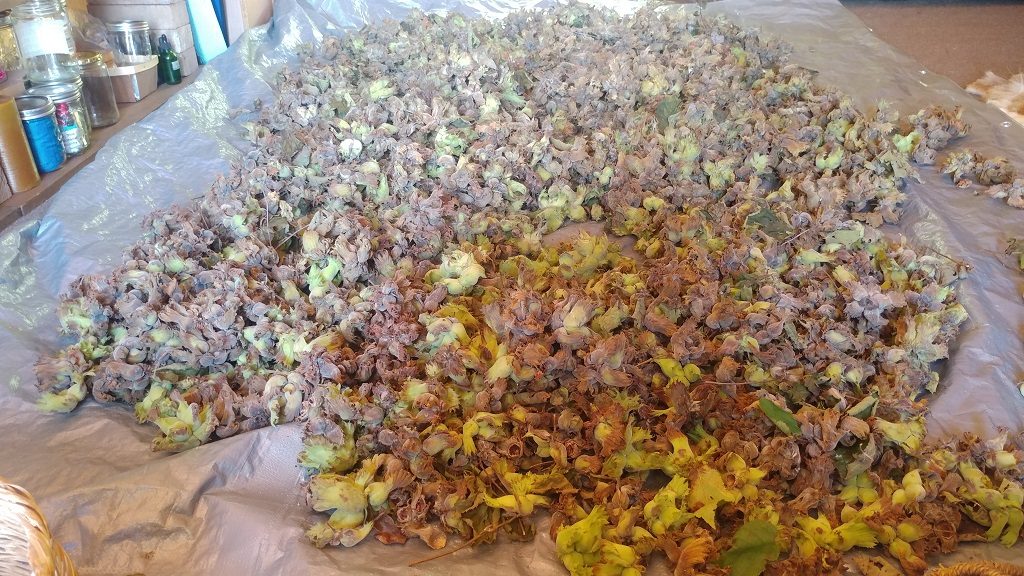
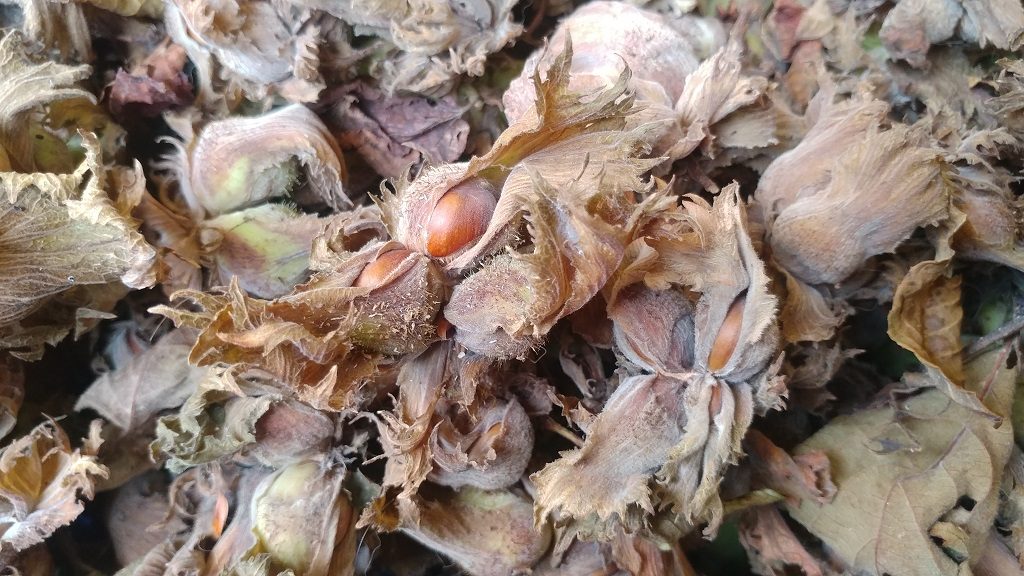
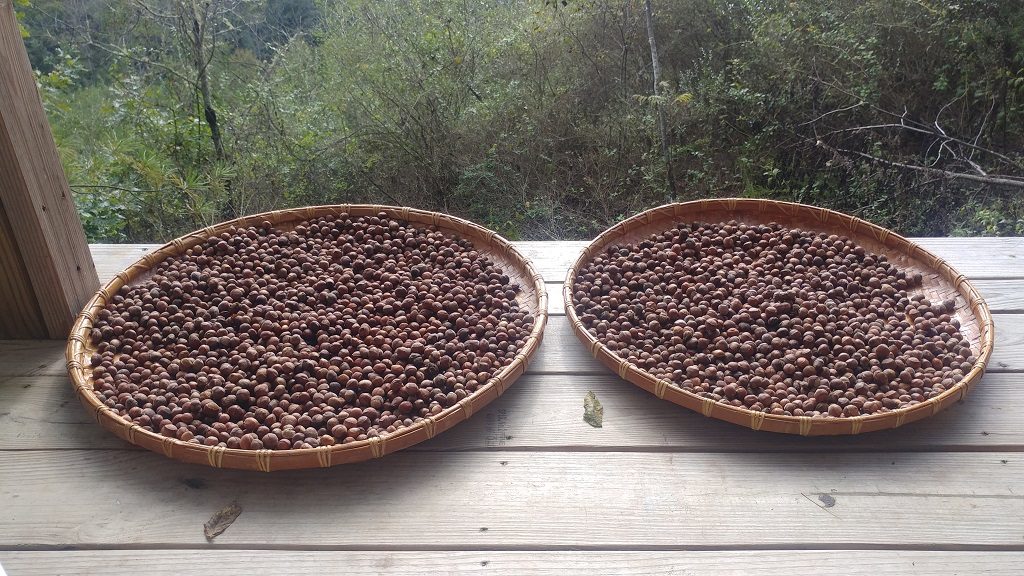
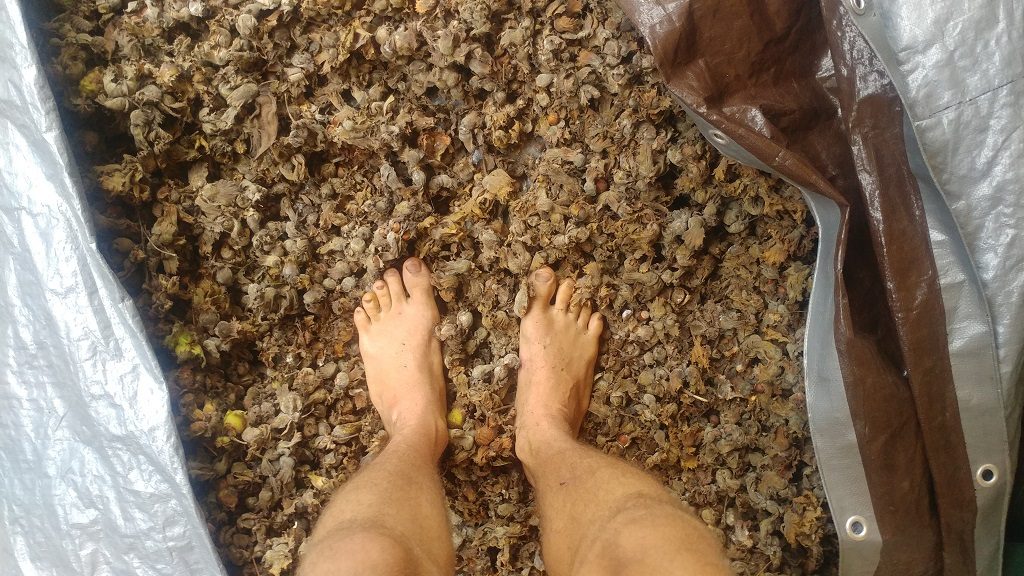
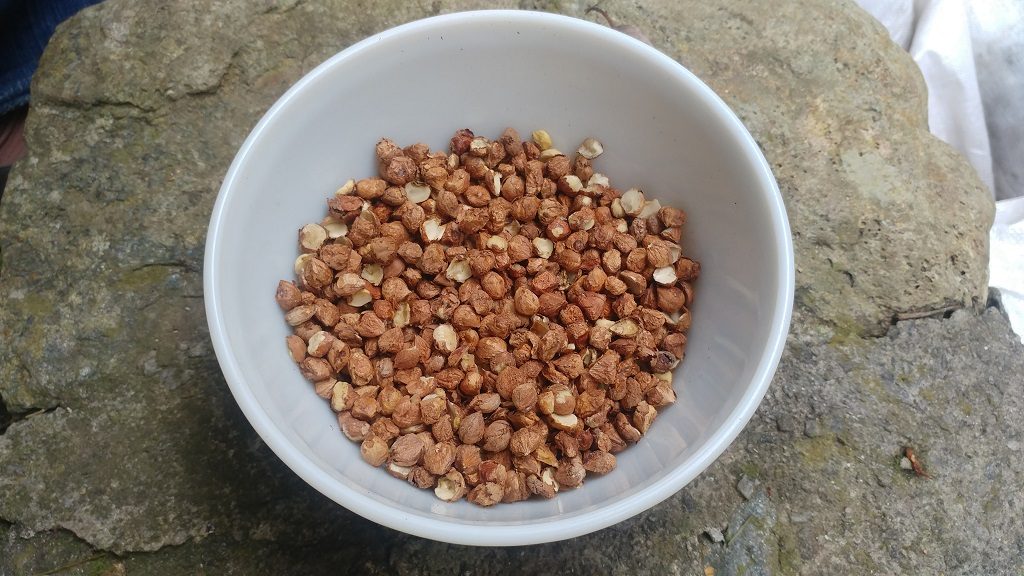
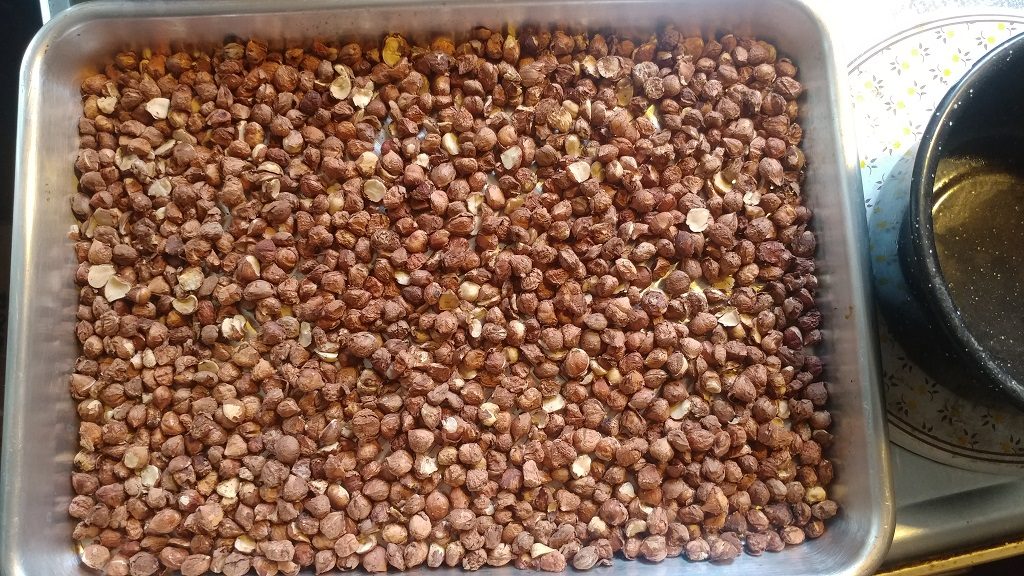
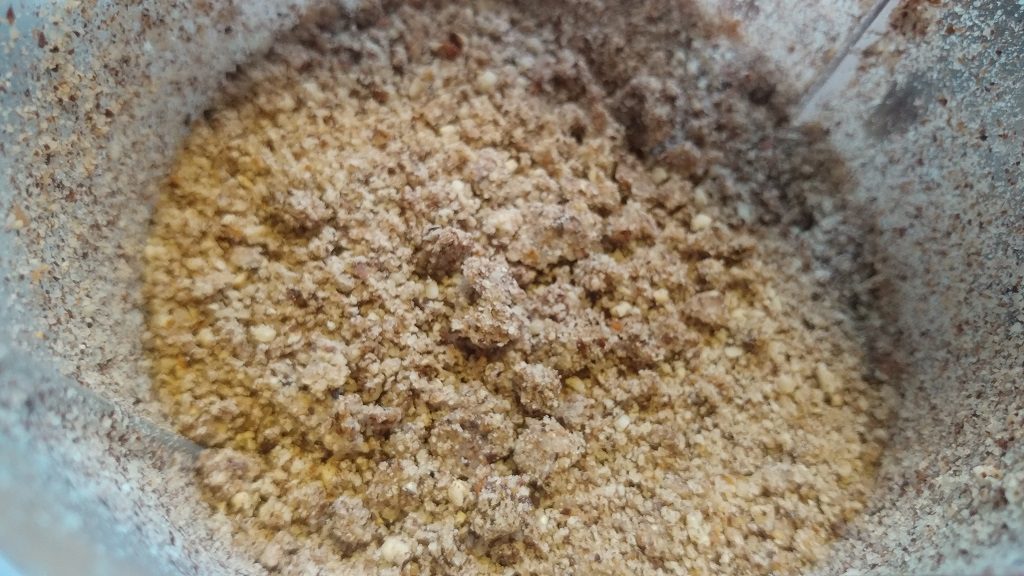
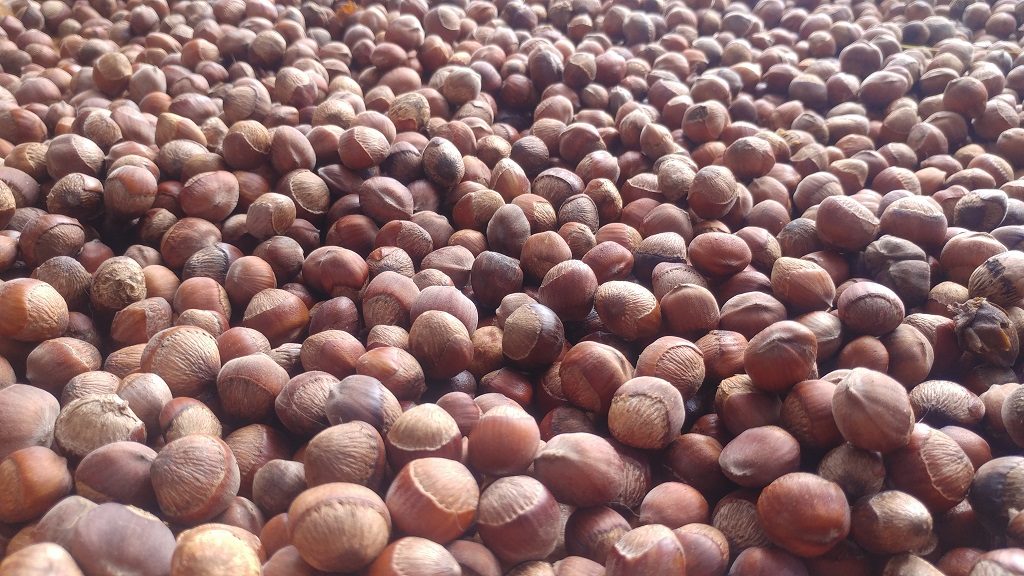
Inspiring! Thank you so much for all the research and smart writing.
Zach,
With your graceful and passionate writing you’ve delivered a truly inspired and inspiring story.
Also; I believe your interest in dissapearing horticultural folkways has a contemporary urgency that must be heard.
No doubt you will keep at it and Art will Happen!
Adrian
Hi Zach
This is a well written research profile complete with
harvesting, uses, propogation, ethnobotony and pics.
Thank you for so much on one page ! 🌰
My favs are chocolate hazelnut milk & hedgehog gelato.
Helena